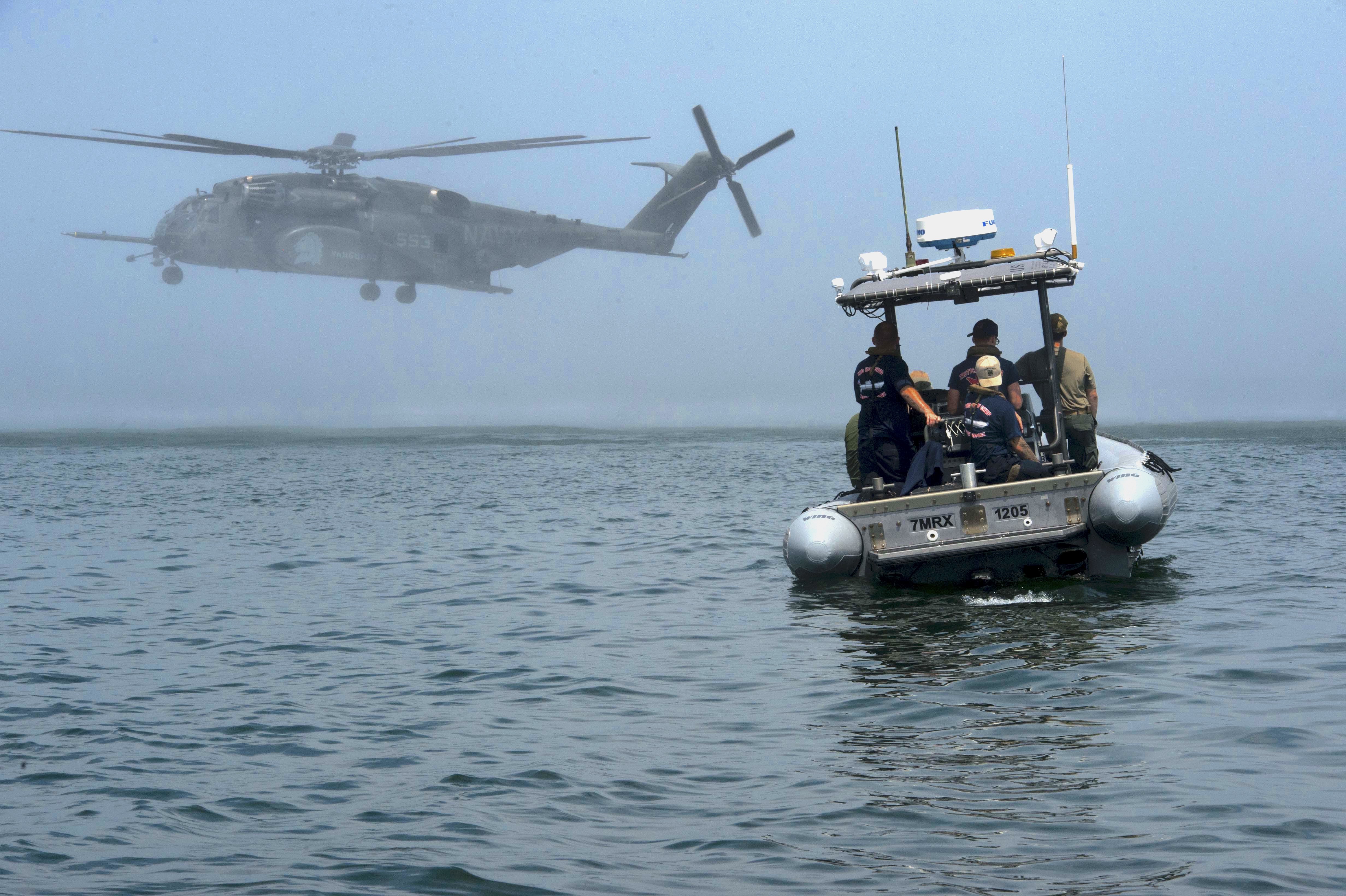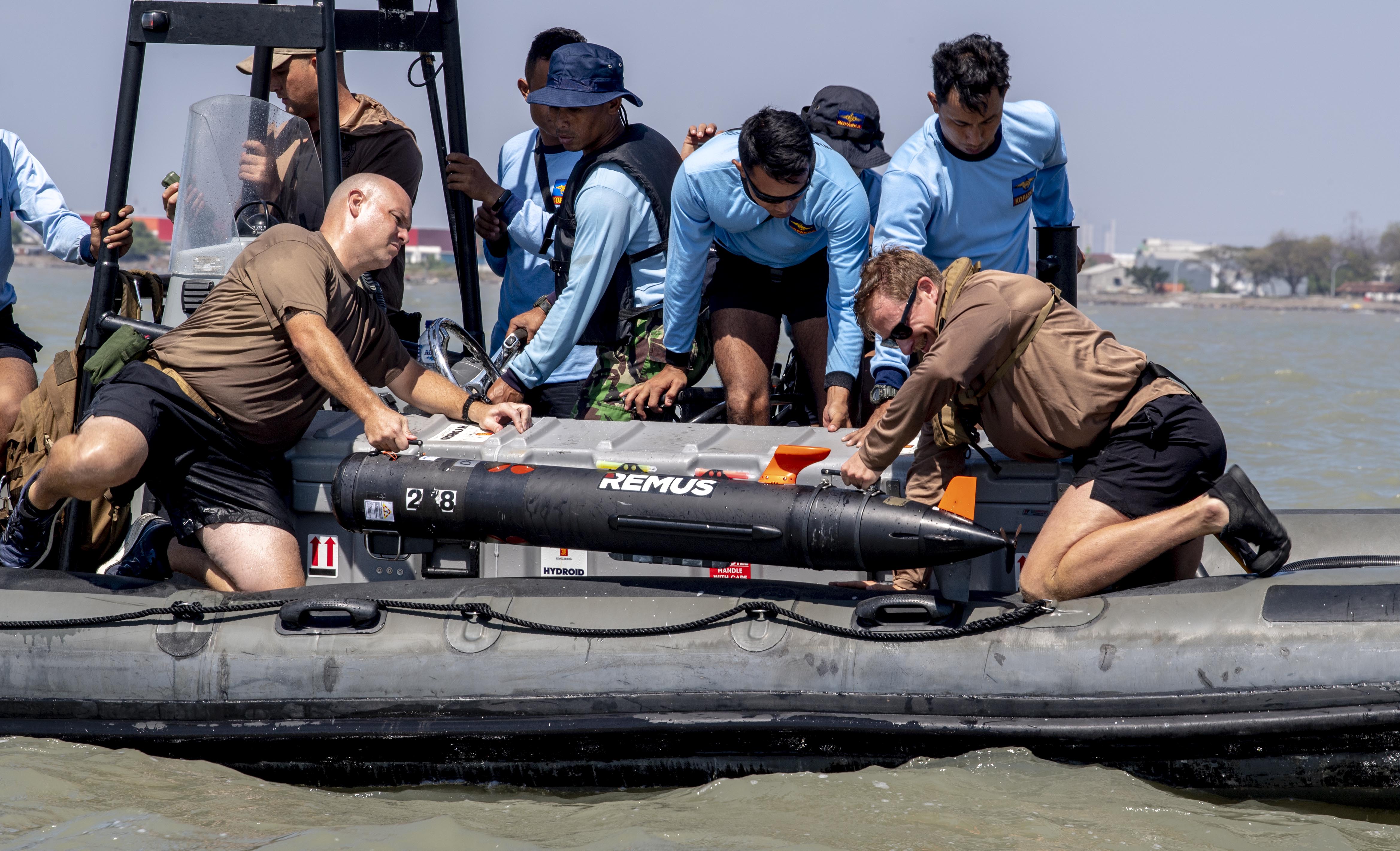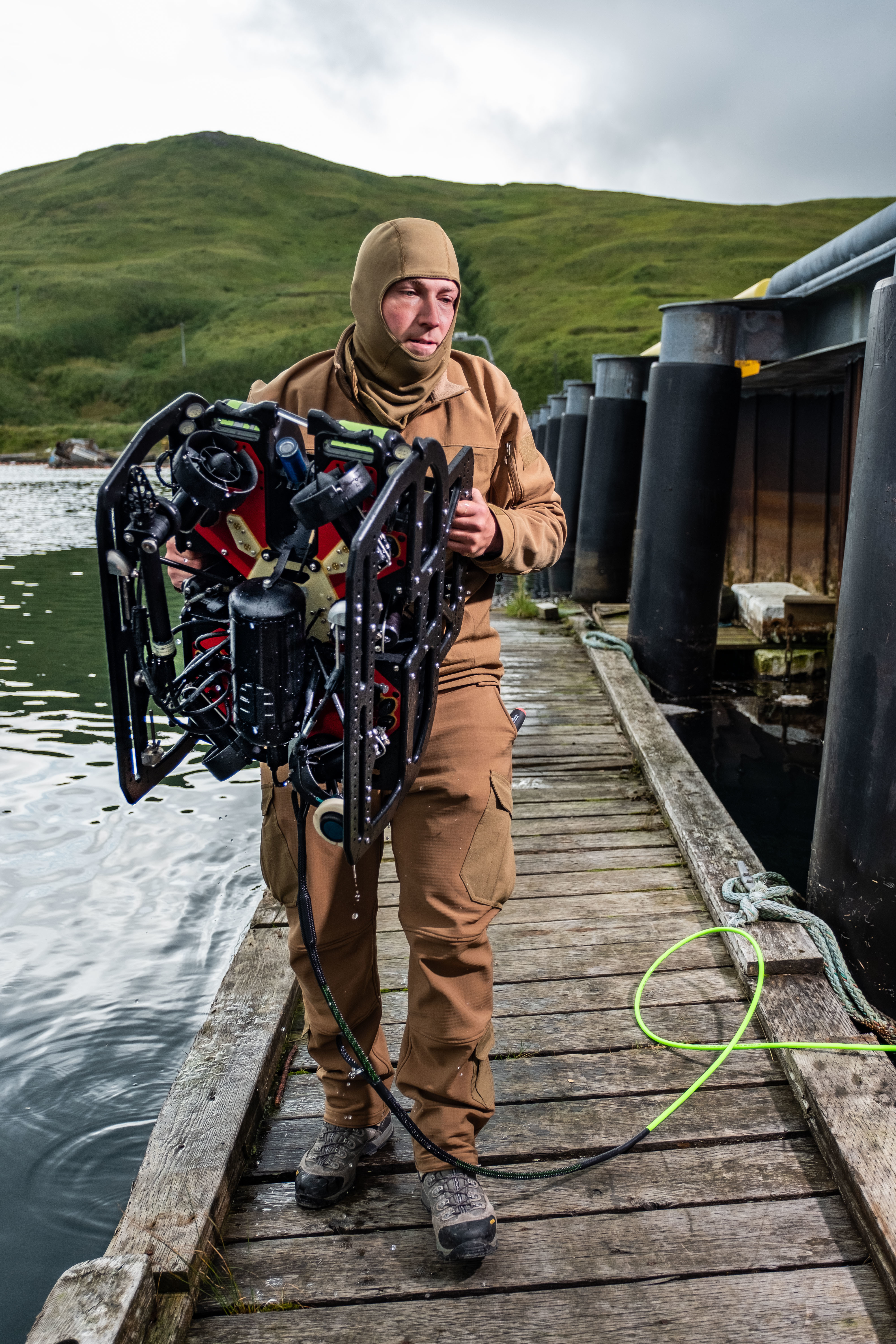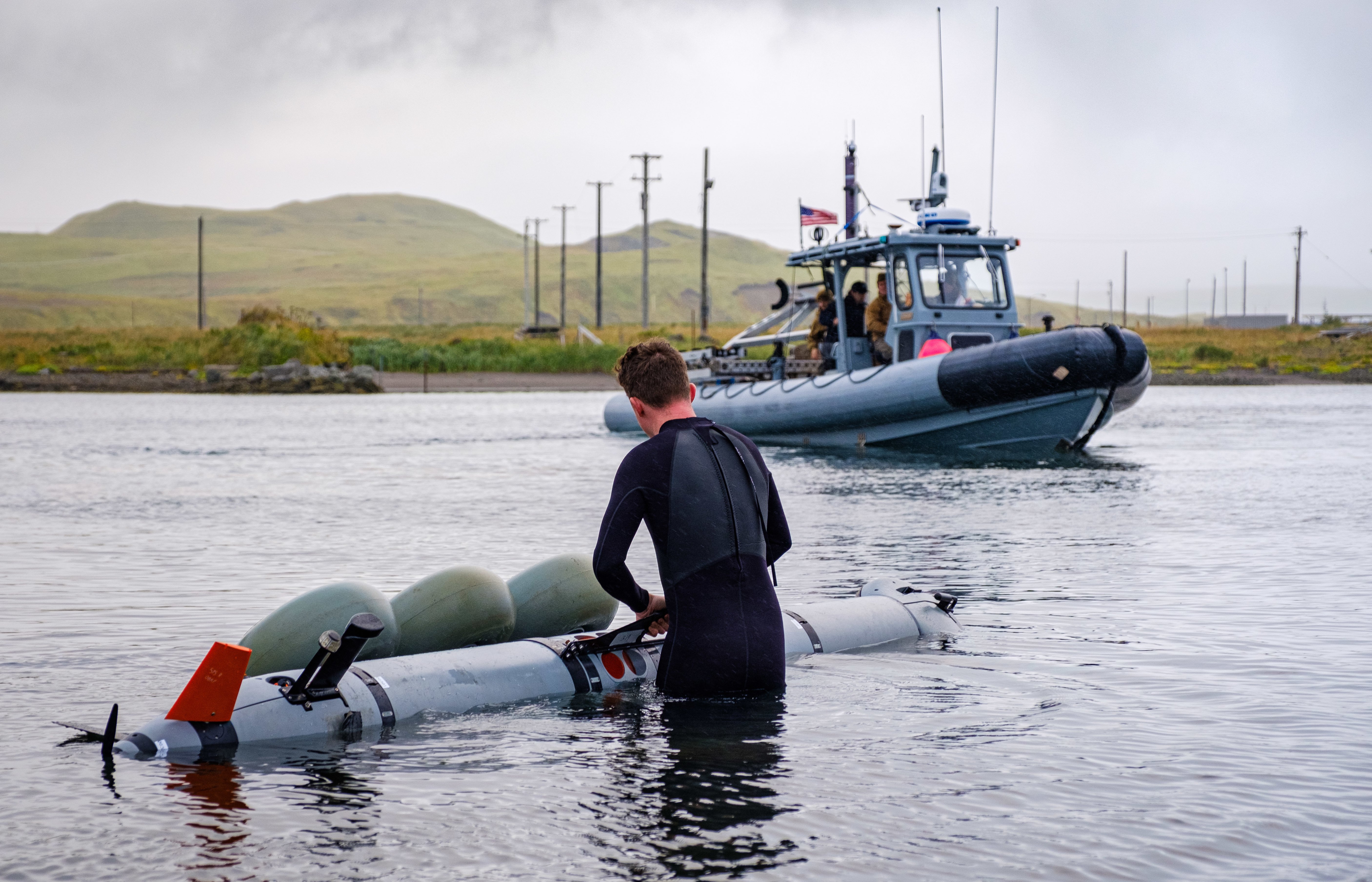
THE PENTAGON – The Navy’s explosive ordnance disposal (EOD) community is modernizing the way it mans, trains and equips its force to leverage new technology and lessons learned in nearly two decades of ground wars in the Middle East.
The community’s new Navy EOD Strategic Vision 2030, rolled out today, seeks to better position the force under the National Defense Strategy and with an eye towards high-end conflict.
“The last time that the Navy EOD community put out a strategic vision was in March of 1997. A lot of things have happened since March of 1997, to include Sept. 11, 2001, and 17 years of combat operations that has forced our community, Navy EOD community, to evolve,” Capt. Oscar Rojas, the commodore of EOD Group 1 in San Diego, told a group of reporters today.
“So it is that threat that has forced Navy EOD to evolve and become the force that it is today, but more importantly, the force that it will be in the future.”
Rojas and his counterpart, Capt. Rick Hayes, the commodore of EOD Group 2 in Virginia Beach, said the Navy EOD community has two missions: supporting the fleet, primarily through Expeditionary Mine Countermeasures (ExMCM) companies that enable freedom of navigation in the maritime environment; and supporting the joint force in its counter-weapons of mass destruction mission, primarily through the special operations force (SOF) platoons that focus on not only rendering devices safe but also conducting intelligence collection efforts to understand who built and placed the device.
For both these mission areas, the Navy EOD force is looking to modernize.
Drawing on 18 years of war in Iraq and Afghanistan, Rojas and Hayes noted a couple of lessons learned that will inform their path forward as the EOD community focuses more on the maritime environment rather than the desert environment.
Rojas said the mine countermeasures community had been using 1950s doctrine to guide its work, but in Iraq and Afghanistan the Navy has realized “the future of warfare is about drones and robots, and we, the Navy EOD community, are taking unmanned systems to be able to get after those threats, not only on the ground but on the surface and in subsurface. And I think that’s unique: we are teaming up the operator and machine’s capabilities in order to be able to operate in a multi-domain environment.”
As for specific tactics that may change in the maritime-based on lessons learned on the ground, Rojas said, the Navy may forego clearing an entire minefield and instead focus on clearing a smaller lane to free up access to a denied area.

In the Middle East ground wars, “in many cases, as Navy EOD was enabling access for the forces that we were supporting into a denied area, once we located an [improvised explosive device], we often just marked it and went around it. Because it’s a time issue – if we need to be on the objective quickly, we at times don’t have the time to be able to neutralize every threat,” Rojas said.
“Same thing on the ocean: the ocean is really big, and in the past the concept was that we would go out there and mow the lawn and clear every explosive threat that’s out there. But because of the importance of time, in some cases, we are just going to clear a path to allow the maritime force to be able to have access into a denied area in order for us to accomplish the objectives that have been set.”
USNI News has previously reported the Navy is experimenting with tools that could help identify the lane that could be most easily cleared with confidence, to allow commanders to make decisions about trying to clear a broader area or simply allowing a narrower area of approach to a beach or through a strait.
Hayes said another lesson the Navy EOD community will carry forward is the importance of weapons technical intelligence collection. He called that a growth area for the community.
In the Middle East, he said, “not only were you addressing the IED, our EOD technicians are now thinking about, where did this thing come from, how was it emplaced, who put it there and why – and all of that stuff is important not only for attribution but to tackle the origins of the actual problem.”
With new technology, he said, the EOD force can do more intelligence collection and can operate more independently. In the past, he noted, Navy EOD divers would primarily wait for Avenger-class MCM ships or MH-53E helicopters to pass through a mine field and pass along any contacts they found that they didn’t or couldn’t neutralize.
“That paradigm has changed now. We own those [unmanned underwater vehicles], we own those search tools as a community now, so that has changed our mindset as well: even though we were involved in the MCM mission planning and the mine warfare planning for decades, we’re into it a little more today for sure because we own those search tools,” Hayes said.
“We operate a ton of unmanned systems, from the Mk 18s to the robots that our folks have been using for years to now the advent of [unmanned aerial systems] in our inventory as well.”
Those unmanned systems native to the EOD community are equipped with much better cameras and sensors than the community had even just a few years ago, making intelligence efforts much easier and more effective. Hayes said that the EOD technicians wouldn’t do intel collection at the expensive of life or property, but he said overall they’ve been trained in recent years to do much more thorough underwater forensics work to collect any potential evidence of who may have placed an explosive and how.

In addition to modernizing how they conduct their work and with what tools, the community is also updating its personnel and training.
Though Navy EOD is the smallest of the Navy’s unrestricted line officer communities, with just 460 officers and 1,200 enlisted sailors, Rojas said the people “are our weapon system” and need to be invested in to maintain a competitive advantage.
To that end, the community is revamping its leadership development career path for officer and enlisted personnel, is seeking to give greater insight into doctrine and policy to those tasked with carrying out missions, looking at new and bundled special pays and bonuses to help with retention, and may be one of the first Navy communities to experiment with the “promote to vacancy” idea that would allow an individual to take on an open job above his or her pay grade in certain circumstances.
The community is also paying special attention to “personal, social, cognitive, physical domains,” Hayes said, with an emphasis on mental health services and physical conditioning for a community for whom combat has been physically and mentally straining over the past nearly two decades.
To that end, a revamp of the deployment cycle may provide some relief.
“We are completely transforming how we do our training cycle that leads up to a certification and deployment, and by revamping how we do training it gives them more time to decompress at home – not only before they deploy but also when they return from deployment they’ll have more quality time at home,” Rojas said.

Navy EOD currently operates off a 24-month cycle that includes one six-month deployment. They are in the midst of a study on that deployment cycle and may move to a cycle of 32 or 36 months that would include two deployments of four to six months. No decisions have been made, and Rojas said the study would be done within the next six to eight months.
Rojas said there were many requirements added to the training cycle since 2001 to keep up with the threats, but with such an intense focus on generating deployable forces, there was little time to take a holistic look at what all those additions had done to training – chiefly, how redundancies and outdated requirements had lengthened the training cycle.
“Now, as we step back and we look at great power competition and the threats that come from that, we have to look at that training cycle, and some things we were training for in order to support the countering violent extremist organizations, the training looks different,” Rojas said.
“So we are revamping that, and it’s going to create white space within that training cycle now to be able to give our warfighters dedicated time to decompress before deployments and also as they return.”
Additionally, that white space in the training – specifically, during the advanced training phase – will also allow unit commanders to brush up on areas where they see deficiencies during basic training, or to add in specialized high-end training for skills they expect to use or environments they expect to operate in during the upcoming deployment. For example, Rojas said a unit could go to a high-altitude range for practice ahead of a deployment, rather than only having time to train at home before deploying.





